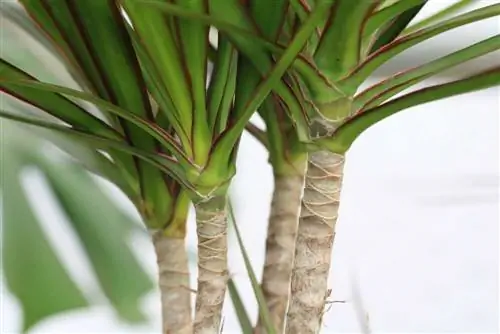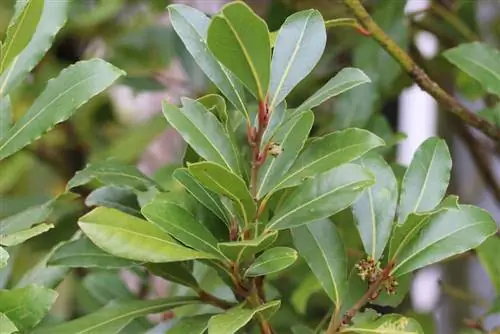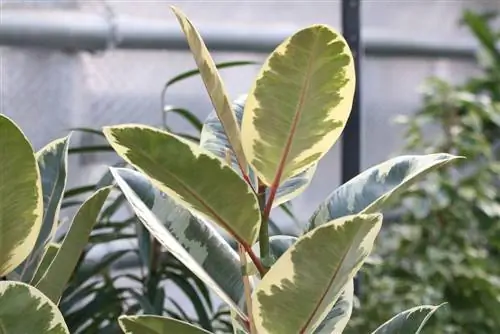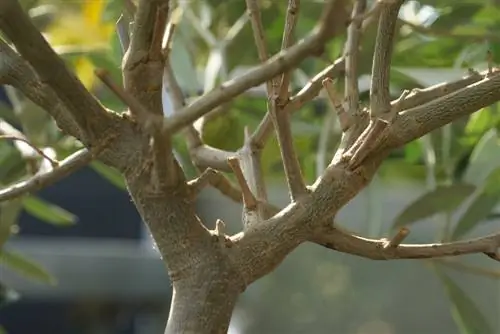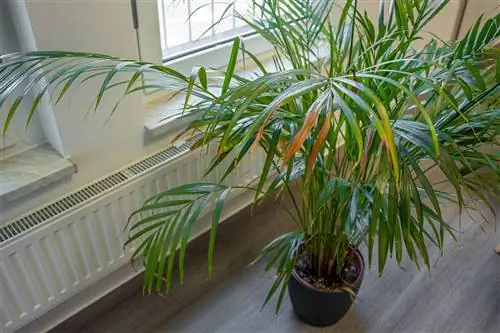- Author admin [email protected].
- Public 2023-12-17 03:39.
- Last modified 2025-01-24 12:45.
The dragon tree (Dracaena) belongs to the asparagus family. Of around 50 subspecies, Dracaena fragrans and Dracaena marginata are the most commonly found in German living rooms. The numerous species differ primarily in the shape, color and pattern of the leaves. Dragon trees can be cut without any problem and, theoretically, sprout new ones from almost any old leaf base or eye below the cut point. They usually develop a maximum of 2 or 3 new side shoots, older specimens often only one.
Cutting for better branching
Dracaena tends to grow relatively quickly, so it can reach a considerable size over the years. Specimens that receive too little light sometimes shoot up and form stunted, long and bare shoots. In these cases, pruning alone is not enough; the site conditions must be optimized at the same time. There is also often a desire for more branched growth. The specimens offered in stores are usually single-stemmed. Regardless of whether you want to shorten the height or achieve better branching, this plant is very tolerant of pruning and can be shortened to almost any height. Normally this plant can be pruned at any time, but preferably in spring, as the cuts should heal more quickly at this time.
The crown can be cut off or the trunk shortened to any height. The cut is always done above a sleeping eye or a shoot bud. Sleeping eyes can be identified by small, flat bulges on the trunk. After cutting, the cut surface should be sealed with tree wax to prevent the trunk from drying out on the cut surface. After about 2-3 weeks, the plant sprouts again below the cut point, ideally several times, so that stronger branching is achieved. The cut plant parts can be used to grow new plants.
Tip:
Basically, the higher up the trunk the cut is made, the better and safer the plant will grow again. If the stem is shortened too radically, it can happen that the remaining stem will only grow out again with great difficulty or not at all, or will only form a new shoot. This is particularly the case with older specimens.
Cutting for propagation purposes
Cut head cuttings correctly
- To propagate the dragon tree, cut the crown, i.e. head cuttings.
- These should be about 20-30 cm long.
- The cut should be made straight and with a sharp tool.
- Keep the cut as small as possible.
- The smaller the cut surface, the lower the risk of bacteria and germs penetrating.
- These could permanently weaken the plant.
- Accordingly, seal the interface on the mother plant with tree wax or charcoal powder.
- This also prevents the cut surfaces from drying out.
- The lower leaves on the cutting are removed.
- The others can be shortened a little if necessary to keep evaporation as low as possible.
- This also stimulates the head cutting to form roots.
- Now let it dry for a day.
Head cutting in substrate
After you have cut the head cutting and allowed it to dry, insert it about halfway into a moist and nutrient-poor substrate, for example a mixture of soil and sand or peat and sand. To ensure an optimal climate, place a translucent plastic bag over the cutting and place the whole thing in a warm, partially shaded place. The substrate should remain evenly moist and the plastic bag should be removed from time to time for ventilation. Too much moisture should be avoided. Rooting occurs after approx. 4-6 weeks.
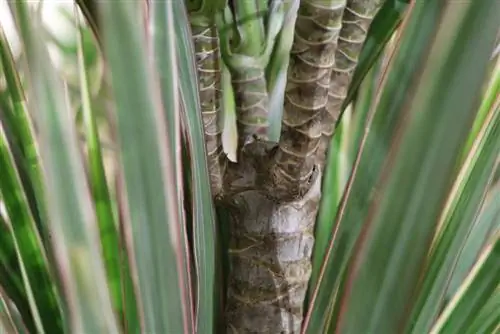
Head cuttings in a water glass
If the crown is relatively large, rooting in a glass of water is a good idea. The water should be changed daily, otherwise rot can quickly occur. If possible, leaves should not be left in the water and should be shortened if necessary. Otherwise, the leaves should remain on the cutting, as the cutting draws nutrients from the leaves for root formation. In order for roots to form soon, the cutting needs a bright and warm place. At temperatures between 21 and 24 °C, rooting occurs within 3-4 weeks. It can then be planted, taking extreme care not to damage or tear off the fine roots.
Tip:
In the first few weeks after planting, leaves may turn brown and wilt. This is because the young plant needs a lot of energy to form roots and draws them from the leaves. Side shoots can also be used to propagate the dragon tree. The procedure is the same as for head cuttings, but they should have at least 5 leaves.
Stem pieces
Propagation via so-called stem cuttings is also very effective. The younger these sections are, the higher the chances of success. To do this, the trunk is cut into 10-20 cm long trunk pieces, depending on the type of dragon tree. It is important to pay attention to the 'top' and 'bottom', because if the wrong end is inserted into the water or soil, no new plant will develop. Each of these trunk pieces should have at least one, or preferably several, buds in order to sprout reliably.
- The upper ends are sealed with wax to protect against drying out.
- Rooting can also take place in a glass of water or directly in the substrate.
- The trunk pieces are placed about a third in soil, e.g. a humus-sand mixture, and moistened.
- A translucent film over the trunk seedling is also recommended here.
- Then place it in a light-flooded and warm place and keep the substrate evenly moist.
When the first tender shoots appear, the cutting has formed roots and has grown. Now the film can be removed and, if necessary, minimally fertilized. As soon as a tuft of leaves has developed, it can be repotted in standard potting soil.
Tip:
Dragon tree cuttings with variegated leaves are usually a solid green initially. The species-typical colors and markings only develop later.
Cutting leaves to obtain leaf cuttings
You rarely read about propagation via leaf cuttings. This method is rarely used because the dragon tree is not exactly predestined for this form of propagation. It is more typical of plants with thick-fleshed leaves. It's still worth a try, especially for species with wider leaves. In spring you cut off one or more leaves on the trunk. This is then inserted into a substrate with the interface at a 45 degree angle, ideally a mixture of sand and propagation soil. The substrate is then moistened and the leaf cuttings are covered with foil. In a warm spot and with a lot of luck, roots should form at the interface after a while and new growth should appear. The original leaf eventually dies.
Conclusion of the editors
There are various reasons to cut the dragon tree, be it because it has become too big or because it should branch out better. When shortening the trunk, care should be taken to make straight cuts and use sharp tools. In addition, you should always cut above sleeping eyes and trunk pieces should always have at least one shoot bud. In some cases it can also be helpful to shorten the leaves.
What you should know about dragon trees in brief

Dragon trees come in a wide variety of varieties with wide or narrow leaves in different colors and some with and some without a trunk. Some varieties are only suitable for a bright location, but some also do well in slightly darker rooms. However, they are all quite easy to care for and are therefore also suitable for beginners or for installation in offices. The dragon tree genus also includes the so-called Lucky Bamboo, which is sold as a single stick in a tube with water or as a step pyramid. Other popular and easy-to-cultivate varieties include:
- Dracaena marginata with thin trunks and narrow leaves. It is particularly easy to care for, grows up to two meters high with good care and thrives quite well even in a relatively dark location.
- Dracaena deremensis has slightly wider leaves that grow in clusters on the trunk. It actually has dark green leaves, but most cultivars have white central stripes or edges.
- Dracaena fragrans has very long leaves that are completely green or multicolored, depending on the variety. The varieties with white or yellow stripes in the middle or on the edge of the leaves are very decorative.
Care
A dragon tree needs a bright location, but should be protected from the blazing sun. Varieties with multi-colored leaves in particular need a lot of light so that they retain their beautiful leaf pattern. In summer a dragon tree needs a lot of water, but in winter it should be watered more sparingly. However, the pot ball should never dry out completely. When it comes to temperature, normal room temperature is just right for dragon trees. The humidity should also be relatively high, otherwise the tips of the leaves will dry out. To prevent this, the leaves can be regularly sprayed with lime-free water in dry rooms.
Cutting and propagating
A dragon tree can grow very large over the years, so it may become too tall. Then in principle it can be shortened at any time, but the best time for this is early spring. The cut shoots usually sprout again soon. To help them with this, some fertilizer for green plants can be given. To protect against drying out, the interface of varieties with a trunk should be sealed with wax or a sealant from a garden supply store. The resulting trunk sections can be used to propagate the dragon tree. To do this, they are placed in a pot with potting soil and always kept slightly moist. It is easiest to root a section of trunk if it is as warm as possible. In slightly cooler locations, this can be achieved by covering the pot with a plastic bag or cling film.

